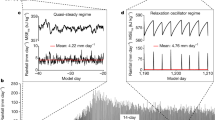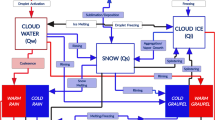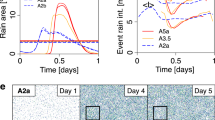Abstract
Cloud fields adopt many different patterns that can have a profound effect on the amount of sunlight reflected back to space, with important implications for the Earth’s climate. These cloud patterns can be observed in satellite images of the Earth and often exhibit distinct cell-like structures associated with organized convection at scales of tens of kilometres1,2,3. Recent evidence has shown that atmospheric aerosol particles—through their influence on precipitation formation—help to determine whether cloud fields take on closed (more reflective) or open (less reflective) cellular patterns4,5. The physical mechanisms controlling the formation and evolution of these cells, however, are still poorly understood6, limiting our ability to simulate realistically the effects of clouds on global reflectance. Here we use satellite imagery and numerical models to show how precipitating clouds produce an open cellular cloud pattern that oscillates between different, weakly stable states. The oscillations are a result of precipitation causing downward motion and outflow from clouds that were previously positively buoyant. The evaporating precipitation drives air down to the Earth’s surface, where it diverges and collides with the outflows of neighbouring precipitating cells. These colliding outflows form surface convergence zones and new cloud formation. In turn, the newly formed clouds produce precipitation and new colliding outflow patterns that are displaced from the previous ones. As successive cycles of this kind unfold, convergence zones alternate with divergence zones and new cloud patterns emerge to replace old ones. The result is an oscillating, self-organized system with a characteristic cell size and precipitation frequency.
This is a preview of subscription content, access via your institution
Access options
Subscribe to this journal
Receive 51 print issues and online access
$199.00 per year
only $3.90 per issue
Buy this article
- Purchase on Springer Link
- Instant access to full article PDF
Prices may be subject to local taxes which are calculated during checkout




Similar content being viewed by others
References
Krueger, A. F. & Fritz, S. Cellular cloud patterns revealed by TIROS I. Tellus 13, 1–7 (1961)
Agee, E. M. Observations from space and thermal convection: a historical perspective. Bull. Am. Meteorol. Soc. 65, 938–949 (1984)
Garay, M. J., Davies, R., Averill, C. & Westphal, J. A. Actinoform clouds: overlooked examples of cloud self-organization at the mesoscale. Bull. Am. Meteorol. Soc. 85, 1585–1594 (2004)
Stevens, B. et al. Pockets of open cells and drizzle in marine stratocumulus. Bull. Am. Meteorol. Soc. 86, 51–57 (2005)
Sharon, T. M. et al. Aerosol and cloud microphysical characteristics of rifts and gradients in maritime stratocumulus clouds. J. Atmos. Sci. 63, 983–997 (2006)
Wood, R. et al. Open cellular structure in marine stratocumulus sheets. J. Geophys. Res. 113 10.1029/2007JD009371 (2008)
Rayleigh, L. On convection currents in a horizontal layer of fluid, when the higher temperature is on the under side. Phil. Mag. 32, 529–546 (1916)
Twomey, S. The influence of pollution on the shortwave albedo of clouds. J. Atmos. Sci. 34, 1149–1152 (1977)
Atkinson, B. W. & Zhang, J.-W. Mesoscale shallow convection in the atmosphere. Rev. Geophys. 34, 403–431 (1996)
Krishnamurti, R. On cellular cloud patterns—Part 1: Mathematical model. J. Atmos. Sci. 32, 1353–1363 (1975)
Getling, A. V. Rayleigh-Bénard Convection: Structures and Dynamics. In Advanced Series in Nonlinear Dynamics Vol. 11 (World Scientific, 2001)
Graham, A. Shear patterns in an unstable layer of air. Phil. Trans. R. Soc. A232, 285–296 (1933)
Helfand, M. & Kalnay, E. A mechanism for open or closed cellular convection. J. Atmos. Sci. 40, 631–650 (1983)
Rosenfeld, D., Kaufman, Y. J. & Koren, I. Switching cloud cover and dynamical regimes from open to closed Benard cells in response to the suppression of precipitation by aerosols. Atmos. Chem. Phys. 6, 2503–2511 (2006)
Savic-Jovcic, V. & Stevens, B. The structure and mesoscale organization of precipitating stratocumulus. J. Atmos. Sci. 65, 1587–1605 (2008)
Xue, H., Feingold, G. & Stevens, B. Aerosol effects on clouds, precipitation, and the organization of shallow cumulus convection. J. Atmos. Sci. 65, 392–406 (2008)
Wang, H. & Feingold, G. Modeling mesoscale cellular structures and drizzle in marine stratocumulus. Part I: Impact of drizzle on the formation and evolution of open cells. J. Atmos. Sci. 66, 3237–3256 (2009)
Baker, M. & Charlson, R. J. Bistability of CCN concentrations and thermodynamics in the cloud-topped boundary layer. Nature 345, 142–145 (1990)
Willis, G. E. & Deardorff, J. W. Laboratory observations of turbulent penetrative-convection planforms. J. Geophys. Res. 84, 295–302 (1979)
Strogatz, S. H. Exploring complex networks. Nature 410, 268–276 (2001)
Arenas, A. et al. Synchronization in complex networks. Phys. Rep. 469, 93–153 (2008)
Yair, Y., Aviv, R. & Ravid, G. Clustering and synchronization of lightning flashes in adjacent thunderstorm cells from lightning location networks data. J. Geophys. Res. 114 D09210 10.1029/2008JD010738 (2009)
Wood, R. et al. Preliminary confrontation of the VOCALS hypotheses with observations and modeling. CLIVAR 7, 5–9 (2009)
Guo, Z., Shi, B. & Zheng, C. A coupled lattice BGK model for the Boussinesq equations. Int. J. Numer. Methods Fluids 39, 325–342 (2002)
Parodi, A., Emmanuel, K. A. & Provenzale, A. Plume patterns in radiative convective flow. New J. Phys. 5, 106.1–106.17 (2003)
Heylighen, F. The science of self-organization and adaptivity. In Encyclopedia of Life Support Systems (EOLSS, 2001)
Wang, H. & Feingold, G. Modeling mesoscale cellular structures and drizzle in marine stratocumulus. Part II: The microphysics and dynamics of the boundary region between open and closed cells. J. Atmos. Sci. 66, 3257–3275 (2009)
Barabási, A.-L. & Albert, R. Emergence of scaling in random networks. Science 286, 509–512 (1999)
Albrecht, B. A. Aerosols, cloud microphysics and fractional cloudiness. Science 245, 1227–1230 (1989)
Wang, H., Feingold, G., Wood, R. & Kazil, J. Modelling microphysical and meteorological controls on precipitation and cloud cellular structures in southeast Pacific stratocumulus. Atmos. Chem. Phys. Discuss. 10, 6347–6362 (2010)
Acknowledgements
We thank NOAA’s Climate Goal Program, a CIRES Visiting Fellowship (I.K.) and the Pacific Northwest National Laboratory (H.W.) for supporting this work. We acknowledge the www.LBMethod.org project for sharing the Lattice Boltzmann Method theory and code, and S. C. Tucker and S. E. Yuter for their support in acquiring the lidar and radar data during the VOCALS-REx field experiment. C. A. Ennis provided editorial assistance and D. Fisher helped with the figures.
Author information
Authors and Affiliations
Contributions
The principal idea was conceived jointly by G.F. and I.K. The large eddy simulations were designed and performed by H.W., H. X. and G.F. I.K. performed the two-dimensional model simulations and the satellite image analysis. W.A.B. performed the analysis of the lidar data. All authors discussed the results and commented on the manuscript.
Corresponding author
Ethics declarations
Competing interests
The authors declare no competing financial interests.
Supplementary information
Supplementary Information
This file contains Supplementary Information comprising: Large Eddy Simulation; Animation of evolving open cellular structure; Animation of coupled oscillator; MSG SEVIRI satellite imagery; Lidar and radar data; Rayleigh-Bénard oscillations resulting from buoyancy reversals using a 2-D model, Legends for Supplementary Movies 1-3, Supplementary Figure S3 with legend and References. (PDF 849 kb)
Supplementary Movie 1 - Supplementary Figure 1
This movie contains an animation of open cellular structures in Fig. 2 (for full legend see Figure 1 in Supplementary Information file page 8). (GIF 2676 kb)
Supplementary Movie 2 - Supplementary Figure
This movie contains an animation of the coupled oscillator (for full legend see Figure 2 in Supplementary Information file page 8). (MOV 17777 kb)
Supplementary Movie 3 - Supplementary Figure 4
This movie shows satellite imagery of oscillating open cells with animation of images at 30 min intervals (for full legend see Figure 4 in Supplementary Information file page 8). (MOV 6614 kb)
Rights and permissions
About this article
Cite this article
Feingold, G., Koren, I., Wang, H. et al. Precipitation-generated oscillations in open cellular cloud fields. Nature 466, 849–852 (2010). https://doi.org/10.1038/nature09314
Received:
Accepted:
Issue Date:
DOI: https://doi.org/10.1038/nature09314
This article is cited by
-
Oscillations in deep-open-cells during winter Mediterranean cyclones
npj Climate and Atmospheric Science (2021)
-
Climate change impacts on wind power generation
Nature Reviews Earth & Environment (2020)
-
Effect of Ocean Warming on Cloud Properties Over India and Adjoining Oceanic Regions
Pure and Applied Geophysics (2020)
-
Turbulence Effects on Precipitation and Cloud Radiative Properties in Shallow Cumulus: an Investigation Using the WRF-LES Model Coupled with Bin Microphysics
Asia-Pacific Journal of Atmospheric Sciences (2018)
-
The Radiative Forcing of Aerosol–Cloud Interactions in Liquid Clouds: Wrestling and Embracing Uncertainty
Current Climate Change Reports (2018)
Comments
By submitting a comment you agree to abide by our Terms and Community Guidelines. If you find something abusive or that does not comply with our terms or guidelines please flag it as inappropriate.



